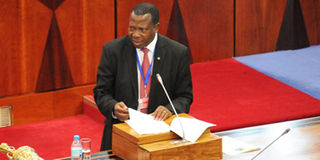Tanzania's external debt stock shrinks marginally

Minister for Finance and Planning, Dr Phillip Mpango. Photo | File
What you need to know:
- The Bank of Tanzania’s monthly economic review for May shows that the external debt shrunk by $128 million to $20,027.7 million in April, down from the $20,156.6 million recorded during the previous month.
Dar es Salaam. Tanzania’s external debt decreased slightly in April from what it was in the previous month.
The Bank of Tanzania’s monthly economic review for May shows that the external debt shrunk by $128 million to $20,027.7 million in April, down from the $20,156.6 million recorded during the previous month.
This is a reduction of nearly Sh300 billion in just one month, thanks to a functional debt services initiative.
By extension, this trend has reduced the overall national debt – which includes both domestic and foreign debt by government and private sector – to Sh59.4 trillion, down from the Sh60 trillion recorded last March.
However, the domestic debt slightly increased in April to Sh14.26 trillion from the Sh14.15 trillion recorded in March.
According to the central bank’s quarterly economic bulletin for March 2018, the government borrowed Sh2,084 million between March 2017 and March 2018 through the domestic debt portfolio.
The growing national debt has fuelled public debate, with MPs calling for a review to determine its sustainability against the country’s ability to finance the provision of services.
MPs, including Mr David Ernest Silinde (Momba-Chadema), recently criticised the government for using the debt-to-GDP ratio in determining debt sustainability.
Arguing that this formula is outdated, they called for debt sustainability to be measured against domestic tax collections.
In his contribution to the Finance ministry budget debate in the august House, Mr Silinde said using the debt-to-GDP ratio methodology does not give a clear picture of the ability of the country to repay debts.
Ms Halima Mdee (Kawe-Chadema) also questioned why the government borrows domestically to pay foreign debt, noting that doing this could plunge the country into vicious debt cycle.
In the event, the government said that the debt is still lower than the set benchmark of 56 per cent of GDP, measured in terms of external debt-to-GDP and external debt-to-exports of goods and services.
In that regard, the government maintains that the national debt is still sustainable, also as indicated by previous debt sustainability assessment conducted by the International Monetary Fund and the World Bank.
Speaking in Parliament when tabling the Finance ministry’s budget estimates for the 2018/19 financial year, the minister for Finance and Planning, Dr Phillip Mpango, stressed that the national debt as measured using the formulae relating to exports and domestic revenue was still sustainable.
Dr Mpango said the suggested formula of debt-to-domestic-revenue cannot of itself determine the sustainability, which must be determined using diverse formulae.
In a related development, the deputy minister for Finance and Planning, Dr Ashatu Kijaji, stated in parliament yesterday that the government plans to conduct a debt sustainability assessment.
Dr Kijaji revealed this when answering a parliamentary question by Mr Masoud Abdallah Salim (Mtambile-CUF) who wanted to know the current status of the national debt.
Dr Kijaji said that, by April this year, Tanzania’s national debt (both government and private sector) stood at $26.161 billion (Sh59.48 trillion).
“The government is responsible for paying back its debt and, during 2017/18, a total of Sh1.26 trillion was allocated for payment of the domestic debt, while the foreign debt was allocated Sh685 billion,” she said.
The deputy minister took the opportunity to assure Tanzanians that the national debt is sustainable, and that the government has never defaulted on its obligations.
The International Monetary Fund and the World Bank also announced last year that they planned to carry out debt sustainability analyses for Tanzania. Past assessments by the two veritable multilateral institutions had always shown that Tanzania’s debt was sustainable.




